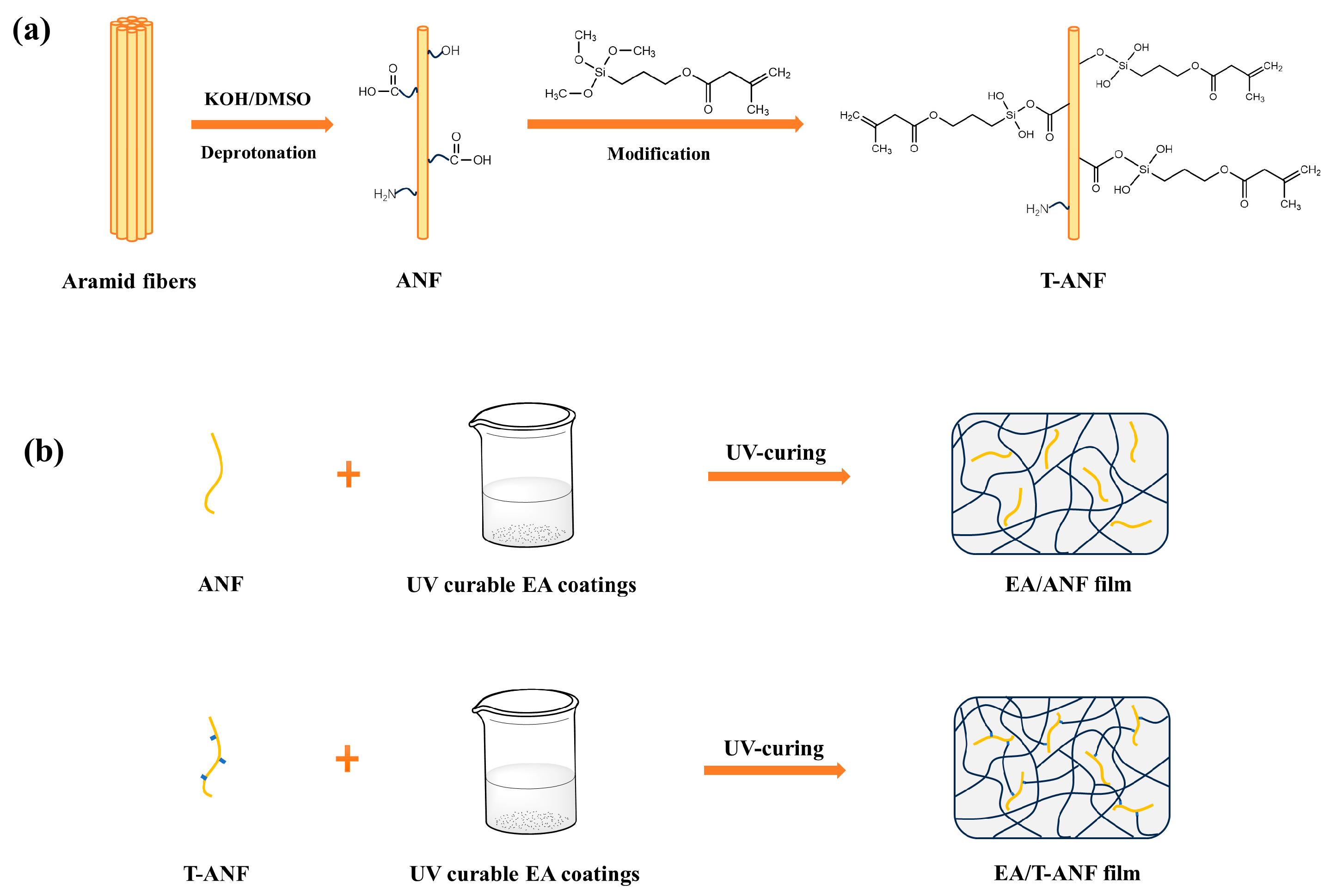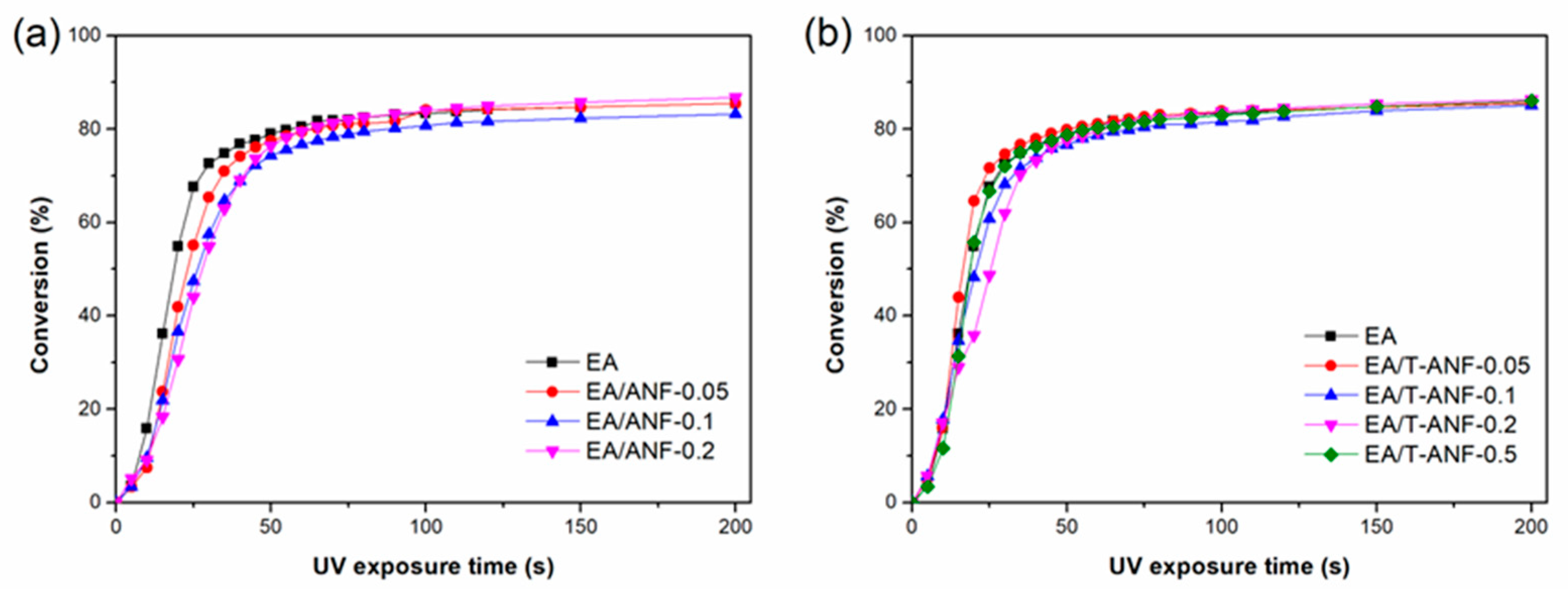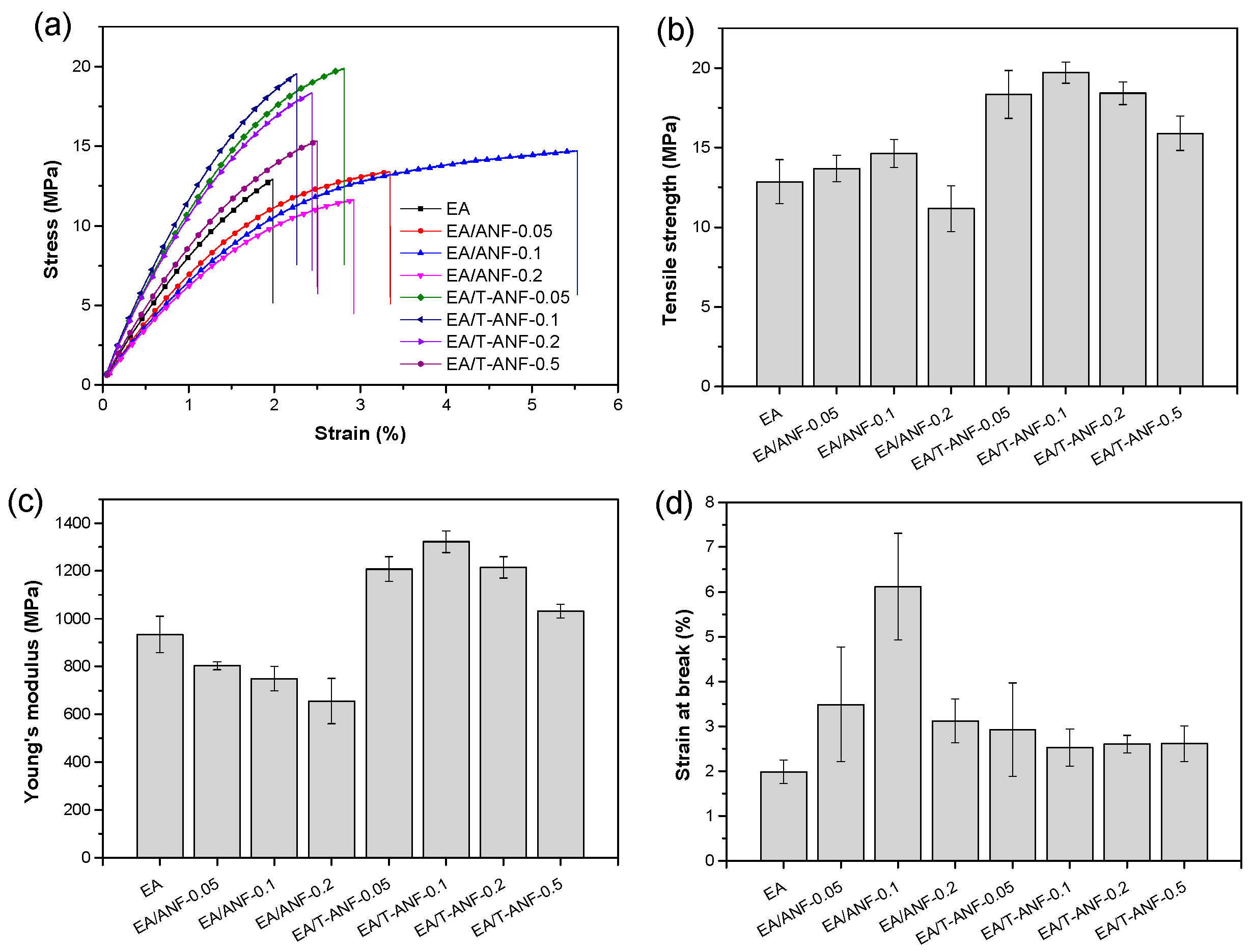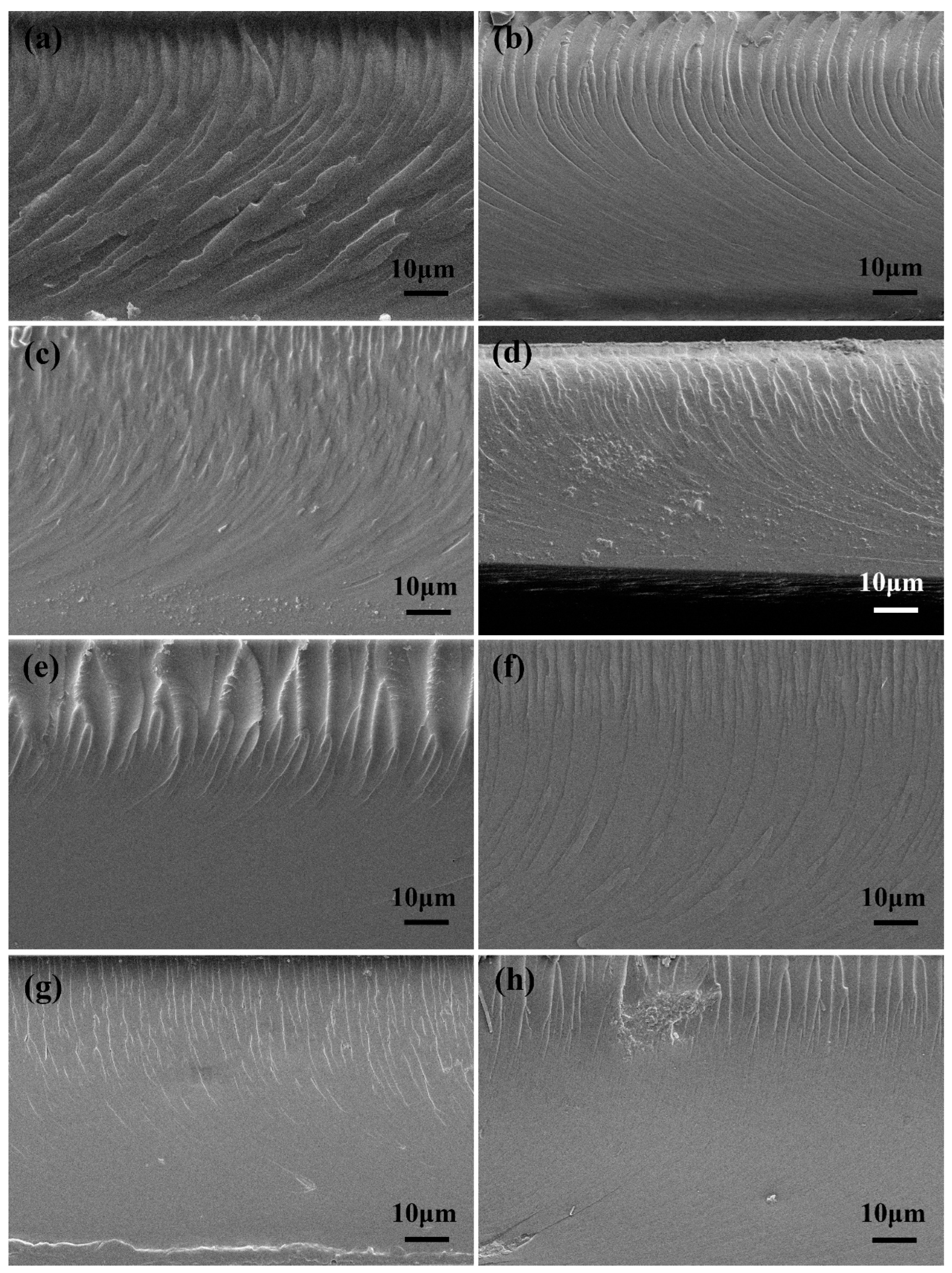Preparation and Mechanical Properties of UV-Curable Epoxy Acrylate/Modified Aramid Nanofiber Nanocomposite Films
Abstract
:1. Introduction
2. Materials and Methods
2.1. Materials
2.2. Synthesis of ANFs
2.3. Synthesis of T-ANF
2.4. Preparation of UV-Curable EA/T-ANF Nanocomposite Films
2.5. Characterization
3. Results and Discussion
3.1. Characterization of T-ANFs
3.2. Curing Kinetics Analysis
3.3. Mechanical Properties of EA/ANF and EA/T-ANF Nanocomposite Films
4. Conclusions
Author Contributions
Funding
Data Availability Statement
Conflicts of Interest
References
- Yang, M.; Cao, K.Q.; Sui, L.; Qi, Y.; Zhu, J.; Waas, A.; Arruda, E.M.; Kieffer, J.; Thouless, M.D.; Kotov, N.A. Dispersions of Aramid Nanofibers: A New Nanoscale Building Block. ACS Nano 2011, 5, 6945–6954. [Google Scholar] [CrossRef]
- Song, J.; Choi, Y.H.; Kim, H.J.; Kim, H.; Eom, Y. Control of reinforcing efficiency in thermoplastic polyurethane/aramid nanofiber nanocomposites: Rheological and two-dimensional correlation spectroscopic approaches. Eur. Polym. J. 2023, 193, 112106. [Google Scholar] [CrossRef]
- Qian, K.P.; Zhou, J.Y.; Miao, M.; Wu, H.; Thaiboonrod, S.; Fang, J. Highly Ordered Thermoplastic Polyurethane/Aramid Nanofiber Conductive Foams Modulated by Kevlar Polyanion for Piezoresistive Sensing and Electromagnetic Interference Shielding. Nano-Micro Lett. 2023, 15, 88. [Google Scholar] [CrossRef]
- He, R.; Xie, C.J.; Chen, Y.X.; Guo, Z.X.; Guo, B.H.; Tuo, X.L. Robust and highly resilient waterborne polyurethane-based composite aerogels prepared by blending with aramid nanofibers. Compos. Sci. Technol. 2022, 228, 109622. [Google Scholar] [CrossRef]
- Jung, J.; Sodano, H.A. Aramid Nanofiber Reinforced Rubber Compounds for the Application of Tire Tread with High Abrasion Resistance and Fuel Saving Efficiency. ACS Appl. Polym. Mater. 2020, 2, 4874–4884. [Google Scholar] [CrossRef]
- Wang, J.Y.; Zhang, X.M.; Wen, Y.W.; Chen, Y.; Fu, Q.; Wang, J.; Jia, H. Aramid Nanofiber/XNBR Nanocomposite with High Mechanical, Thermal, and Electrical Performance. Nanomaterials 2023, 13, 335. [Google Scholar] [CrossRef]
- Jung, J.; Sodano, H.A. Synergetic effect of aramid nanofiber-graphene oxide hybrid filler on the properties of rubber compounds for tire tread application. J. Appl. Polym. Sci. 2022, 139, e51856. [Google Scholar] [CrossRef]
- Chen, Y.; Yin, Q.; Zhang, X.M.; Zhang, W.; Jia, H.; Ji, Q.; Yang, F.; Rui, X. Rational design of multifunctional properties for styrene-butadiene rubber reinforced by modified Kevlar nanofibers. Compos. Part B-Eng. 2019, 166, 196–203. [Google Scholar] [CrossRef]
- Tung, H.T.; Lee, G.H.; Luan, V.H.; Lim, S.; Kang, H.W.; Lee, W. Highly dispersed aramid nanofiber-reinforced epoxy nanocomposites by the sequential solvent-exchange method. Adv. Compos. Mater. 2023, 32, 350–367. [Google Scholar] [CrossRef]
- Zhou, G.D.; Wang, W.T.; Peng, M. Functionalized aramid nanofibers prepared by polymerization induced self assembly for simultaneously reinforcing and toughening of epoxy and carbon fiber/epoxy multiscale composite. Compos. Sci. Technol. 2018, 168, 312–319. [Google Scholar] [CrossRef]
- Jung, J.; Sodano, H.A. High strength epoxy nanocomposites reinforced by epoxy functionalized aramid nanofibers. Polymer 2020, 195, 122438. [Google Scholar] [CrossRef]
- Guan, Y.; Li, W.; Zhang, Y.; Shi, Z.; Tan, J.; Wang, F.; Wang, Y. Aramid nanofibers and poly (vinyl alcohol) nanocomposites for ideal combination of strength and toughness via hydrogen bonding interactions. Compos. Sci. Technol. 2017, 144, 193–201. [Google Scholar] [CrossRef]
- Guo, D.; Mu, C.P.; Liu, Q.; Wang, B.; Xiang, J.; Nie, A.; Zhai, K.; Shu, Y.; Xue, T.; Wen, F.; et al. Aramid Nanofiber/Polypyrrole Composite Films for Broadband EMI Shielding, Wearable Electronics, Joule Heating, and Photothermal Conversion. ACS Appl. Nano Mater. 2023, 6, 15108–15118. [Google Scholar] [CrossRef]
- Gharieh, A.; Pourghasem, M. Eco-friendly UV-curable polyurethane-silica superhydrophobic coating with superb mechanical durability. Polym. Adv. Technol. 2022, 33, 3312–3322. [Google Scholar] [CrossRef]
- Calvez, I.; Szczepanski, C.R.; Landry, V. Preparation and characterization of low gloss UV-curable coatings based on silica surface modification using an acrylate monomer. Prog. Org. Coat. 2021, 158, 106369. [Google Scholar] [CrossRef]
- Ingrosso, C.; Corcione, C.E.; Striani, R.; Comparelli, R.; Striccoli, M.; Agostiano, A.; Curri, M.L.; Frigione, M. UV-Curable Nanocomposite Based on Methacrylic-Siloxane Resin and Surface-Modified TiO2 Nanocrystals. ACS Appl. Mater. Int. 2015, 7, 15494–15505. [Google Scholar] [CrossRef] [PubMed]
- Malucelli, G.; Fioravanti, A.; Francioso, L.; De Pascali, C.; Signore, M.A.; Carotta, M.C.; Bonanno, A.; Duraccio, D. Preparation and characterization of UV-cured composite films containing ZnO nanostructures: Effect of filler geometric features on piezoelectric. Prog. Org. Coat. 2017, 109, 45–54. [Google Scholar] [CrossRef]
- Melinte, V.; Chibac, A.; Buruiana, T.; Buruiana, E.C. Hybrid nanocomposites prepared by in situ photopolymerization using photoinitiator-modified montmorillonite. Prog. Org. Coat. 2017, 104, 125–134. [Google Scholar] [CrossRef]
- Xie, H.; Wu, Q.H.; Shi, W.F. Preparation of photopolymerized nanocomposites through intercalating multifunctional acrylated siloxane into montmorillonite. Appl. Clay Sci. 2014, 99, 164–170. [Google Scholar] [CrossRef]
- Wang, Y.; Cao, Z.C.; Liu, F.G.; Xue, X.X. Synthesis and characterization of UV-curing epoxy acrylate coatings modified with organically modified rectorite. J. Coat. Technol. Res. 2017, 14, 107–115. [Google Scholar] [CrossRef]
- Jeong, Y.G. An JEJPI. UV-cured Epoxy/Graphene Nanocomposite Films: Preparation, Structures and Electric Heating Performance. Polym. Int. 2014, 63, 1895–1901. [Google Scholar] [CrossRef]
- Yu, B.; Shi, Y.; Yuan, B.; Liu, L.; Hu, Y.J.R.A. Click-chemistry approach for graphene modification: Effective reinforcement of UV-curable functionalized graphene/polyurethane acrylate nanocomposites. RSC Adv. 2015, 5, 13502–13506. [Google Scholar] [CrossRef]
- Huang, L.J.; Wang, Y.A.; Wei, Z.H.; Han, X.; Mo, Q.; Wang, X.; Li, Y. Synthesis and Optimization of a Free-Radical/Cationic Hybrid Photosensitive UV Curable Resin Using Polyurethane Acrylate and Graphene Oxide. Polymers 2022, 14, 1959. [Google Scholar] [CrossRef] [PubMed]
- Jafarifard, S.; Ebrahimi, M.; Sharif, F. Antistatic epoxy acrylate/graphene oxide UV-curable coatings with improved shrinkage and adhesion strength. Prog. Org. Coat. 2023, 182, 107595. [Google Scholar] [CrossRef]
- Mendes-Felipe, C.; Oliveira, J.; Costa, P.; Ruiz-Rubio, L.; Iregui, A.; González, A.; Vilas, J.L.; Lanceros-Mendez, S. Stimuli responsive UV cured polyurethane acrylated/carbon nanotube composites for piezoresistive sensing. Eur. Polym. J. 2019, 120, 109226. [Google Scholar] [CrossRef]
- Wang, Y.; Liu, F.G.; Xue, X.X. Morphology and properties of UV-curing epoxy acrylate coatings modified with methacryl-POSS. Prog. Org. Coat. 2015, 78, 404–410. [Google Scholar] [CrossRef]
- Wang, Y.; Liu, F.G.; Xue, X.X. Synthesis and characterization of UV-cured epoxy acrylate/POSS nanocomposites. Prog. Org. Coat. 2013, 76, 863–869. [Google Scholar] [CrossRef]
- Gao, J.G.; Lv, H.Q.; Zhang, X.F.; Zhao, H.C. Synthesis and properties of waterborne epoxy acrylate nanocomposite coating modified by MAP-POSS. Prog. Org. Coat. 2013, 76, 1477–1483. [Google Scholar] [CrossRef]
- Wang, X.F.; Wang, X.; Song, L.; Xing, W.; Tang, G.; Hu, W.; Hu, Y. Preparation and thermal stability of UV-cured epoxy-based coatings modified with octamercaptopropyl POSS. Thermochim. Acta 2013, 568, 130–139. [Google Scholar] [CrossRef]
- Wang, Y.; Qu, R.J.; Pan, Y.K.; Luo, Y.; Zhang, Y.; Sun, C.; Ji, C. High-performance UV-curable epoxy acrylate nanocomposite coatings reinforced with aramid nanofibers. Prog. Org. Coat. 2022, 163, 106631. [Google Scholar] [CrossRef]
- Patterson, B.A.; Malakooti, M.H.; Lin, J.J.; Okorom, A.; Sodano, H.A. Aramid nanofibers for multiscale fiber reinforcement of polymer composites. Compos. Sci. Technol. 2018, 161, 92–99. [Google Scholar] [CrossRef]
- ASTM D882-18; Standard Test Method for Tensile Properties of Thin Plastic Sheeting. ASTM International: West Conshohocken, PA, USA, 2018.
- Dong, C.C.; Guo, P.; Yuan, Y.; Sun, C.; Qu, R.; Ji, C.; Zhang, Y.; Wang, Y. Aramid nanomaterials of various morphologies: Preparation and mechanical property enhancement. Front. Chem. 2020, 7, 939. [Google Scholar] [CrossRef] [PubMed]
- Prosvirnina, A.P.; Bugrov, A.N.; Dobrodumov, A.V.; Vlasova, E.N.; Fedotova, V.S.; Nikolaeva, A.L.; Vorobiov, V.K.; Sokolova, M.P. Bacterial cellulose nanofibers modification with 3-(trimethoxysilyl)propyl methacrylate as a crosslinking and reinforcing agent for 3D printable UV-curable inks. J. Mater. Sci. 2022, 57, 20543–20557. [Google Scholar] [CrossRef]
- Lu, Z.; Si, L.; Dang, W.; Zhao, Y. Transparent and mechanically robust poly (para-phenylene terephthamide) PPTA nanopaper toward electrical insulation based on nanoscale fibrillated aramid-fibers. Compos. Part A-Appl. Sci. Manuf. 2018, 115, 321–330. [Google Scholar] [CrossRef]
- Yang, B.; Wang, L.; Zhang, M.; Lu, Z.; Tan, J.; Luo, J.; Lu, P. Water-resistant, transparent, uvioresistant cellulose nanofiber (CNF)–aramid nanofiber (ANF) hybrid nanopaper. Mater. Lett. 2019, 240, 165–168. [Google Scholar] [CrossRef]
- Çanak, T.; Kaya, K.; Serhatli, I.E. Boron containing UV-curable epoxy acrylate coatings. Prog. Org. Coat. 2014, 77, 1911–1918. [Google Scholar] [CrossRef]
- Yan, F.; Bao, F.; Yan, S.; Lan, Z.; Weng, F.; Ding, H.; Ma, R. Hyperbranched polysiloxane-modified UV-curable graphene conductive coatings: Preparation and characterization. Iran Polym. J. 2018, 27, 939–949. [Google Scholar] [CrossRef]
- Guan, X.X.; Gan, J.Q.; Chen, G.K.; Huang, X.M.; Lu, M.G.; Wu, K.; Liang, L.Y.; Shi, J. UV-cured hyperbranched polyester polythiol(H20-SH)-epoxy acrylate networks: Preparation, thermal and mechanical properties. J. Macromol. Sci. A 2017, 54, 662–668. [Google Scholar] [CrossRef]






Disclaimer/Publisher’s Note: The statements, opinions and data contained in all publications are solely those of the individual author(s) and contributor(s) and not of MDPI and/or the editor(s). MDPI and/or the editor(s) disclaim responsibility for any injury to people or property resulting from any ideas, methods, instructions or products referred to in the content. |
© 2023 by the authors. Licensee MDPI, Basel, Switzerland. This article is an open access article distributed under the terms and conditions of the Creative Commons Attribution (CC BY) license (https://creativecommons.org/licenses/by/4.0/).
Share and Cite
Wang, Y.; Sun, Z.; Yin, P.; Qu, R.; Zhang, Y.; Sun, C. Preparation and Mechanical Properties of UV-Curable Epoxy Acrylate/Modified Aramid Nanofiber Nanocomposite Films. Nanomaterials 2023, 13, 2960. https://doi.org/10.3390/nano13222960
Wang Y, Sun Z, Yin P, Qu R, Zhang Y, Sun C. Preparation and Mechanical Properties of UV-Curable Epoxy Acrylate/Modified Aramid Nanofiber Nanocomposite Films. Nanomaterials. 2023; 13(22):2960. https://doi.org/10.3390/nano13222960
Chicago/Turabian StyleWang, Ying, Zhenxing Sun, Peixu Yin, Rongjun Qu, Ying Zhang, and Changmei Sun. 2023. "Preparation and Mechanical Properties of UV-Curable Epoxy Acrylate/Modified Aramid Nanofiber Nanocomposite Films" Nanomaterials 13, no. 22: 2960. https://doi.org/10.3390/nano13222960



